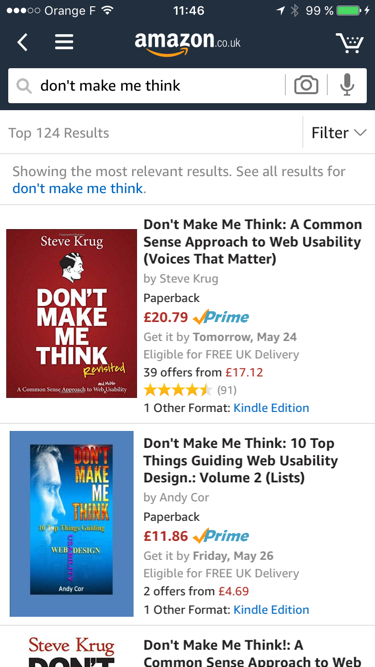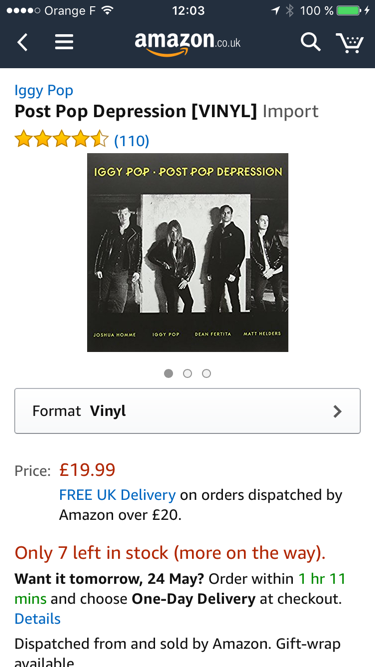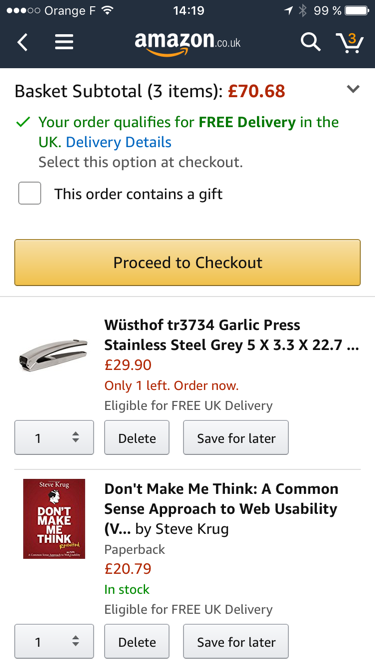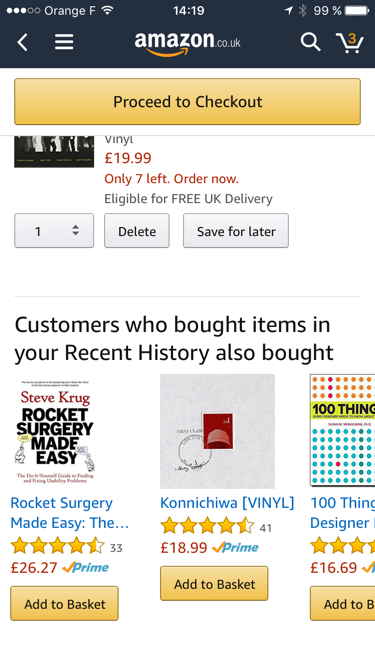Over the past couple of years, my iPhone has become my most enthusiastic shopping mall. Within reach, I can find books, vinyls or kitchen utensils, etc. For my online purchases, I look for a fast, simple and comprehensive service.

Amazon: from manipulation to User Experience
I buy almost exclusively through Amazon. This e-commerce site meets 82% of my expectations. I regularly sail there for the pleasure of antiquing. At the turn of a page, I slip a spinner, a book or a record into my basket...
I feel totally free of my navigation and master of my actions during my navigation on their service… or almost. However, a few weeks ago, I ordered The little treatise on manipulation for the use of honest people by Joule & Beauvois. These two teacher-researchers decipher different manipulation techniques at work in our daily lives and seek to answer this question:
“How do you get someone to do what you want?”
In mode shadowing, I observed myself as a User. I decided to place an order on Amazon by analyzing at what point in my journey, what technique was at work.
This exercise of distancing as well as the scientific contribution of the two researchers, leads me to take a critical and benevolent look at the techniques for building user paths.
Yes, we use these manipulation techniques; probably, we can do it with more relevance and in a more empathetic approach towards users.
How did I allow myself to be manipulated?
Joule & Beauvois point out that these skills work just as well on individuals familiar with manipulation as on the rest of the population. The techniques used are based on deep cognitive and emotional springs.
Any manipulation action takes place in two phases: commitment and transformation.
How to create a favorable context for engagement?
Amazon immediately establishes a close relationship with the user by focusing its interface on the user's needs: guiding the user, taking an interest in his needs... A small anthology of techniques put at the service of the user experience and the increase in conversion rates.
The technique of toucher
let's make a  detour via the city of Marseille. It is common that in the markets, a seller takes you by the arm to invite you to taste his fruits, and there is a good chance that you will follow him.
detour via the city of Marseille. It is common that in the markets, a seller takes you by the arm to invite you to taste his fruits, and there is a good chance that you will follow him.
Why?
Touch alters our judgments and moods. This phenomenon is all the more troubling since it is not necessary to remember having been touched in order to be influenced.
How did they apply the “touch”?
Like the market gardener, Amazon came back to me offering garlic presses. This purchase is not forced: the selection of products and the contact previously made have significantly influenced me in my passage to the act.
Creating intimacy with our users develops a favorable context for engagement in the service.
The technique of foot in mouth

In the 90s, a Howard, a psychology researcher, set up an experiment. He wants to sell cookies over the phone for charity. Half the time, he begins his dialogue with: “How are you today ? (...) I am very happy that you are well".
The engagement rate increases from 10% to 25%. However, it is not politeness that triggers commitment as we might imagine. A much stronger spring is at play: the feeling of being able to choose one's response. And if this response is positive, then 46% of respondents buy cookies. Commitment to an action is therefore correlated to the mood of the user. Another team of researchers reinforced these results by demonstrating the importance of contextualizing the question.
"What are you looking for?”: question of commitment
And in an almost reflex, I type “don't make me think”… As far as I decided to answer the question, I had to fill in the input field. And of course, see me submit a list of products corresponding to my search.
Moreover, the turn of their question leaves no room for doubt about the action to be taken. I have a need and Amazon will help me meet it.
The wording of the question influences the mood and engagement of the user. Content is part of engagement.
The technique of fear-then-relief

In order to test the effect of fear on commitment, researchers let pedestrians cross outside authorized passages. One out of two pedestrians in violation is arrested by a whistle. Turning around, they see (with relief) that it is not a police officer. They continue on their way. Moments later, they are asked to make a donation for charity. 62,2% of people arrested beforehand give money and the average amount of donations is 60% higher.
Amazon: I can get satisfaction
Following a discussion with a friend, I had also decided to look at the price of Post Pop Depression by Iggy Pop on vinyl.
"Only 7 left in stock (more on the way). Want it tomorrow, 24 may? Order within 1hr 7 mins…"
Thus, for fear of not being able to obtain this album and for the satisfaction of being able to listen to it the next day, I added this product to my basket. I must add, that my intimate relationship with Amazon encouraged me to free myself from this impulse to buy.
The combined action of intimacy, fear and then relief contributes to creating the conditions of stress favorable to immediate decision-making by the user.
How to properly formulate your (non)-request?
The transformation of the desire to buy into a validated payment is a delicate operation. Dropout rates are very high at 76,8%. Amazon mainly employs two techniques in order to mitigate this phenomenon…
The technique of But-you-are-free-to

The feeling of control in an interface is an important ergonomic criterion. It authorizes the user to interrupt his navigation. Paradoxically, opening the door reinforces user engagement.
Researchers have observed volunteers at holiday parties selling calendars. In order to increase their sales potential, they do this: “It's 5€ but you are free to give what you want...“They saw a 25% increase in donations.
If I can do it later, why not buy now?
Amazon offers an actionable shopping cart from which I can add, remove or set aside selected products. So I'm free to buy any (or all) of the items later. However, it is very likely that my desire to possess immediately (or as quickly as possible) takes precedence over reason. The freedom that Amazon gives me encourages me to transform immediately.
The shopping cart becomes the place of a new experience with the user: giving the user back his freedom after having guided him so far.
The technique of That's not all

Let's go back to my fruit & vegetable seller. At the time of payment, he will most certainly offer you a punnet of cherries at a relatively high price. Then a few seconds later, he will present you with a nice melon at a lower price and ask your neighbor “Isn't this melon beautiful, sir? “The opinion of the buyer next to you will strengthen your desire for fruit. You will certainly give in on the melon. This is a classic trading technique.
Customers who bought items in your Recent History also bought…
During my basket summary, Amazon kindly informs me that buyers with the same profile as mine have also purchased these books. Steve Krug is £27.27. On the other hand, 100 Things Every Designer Needs to Know about People is £16.69. It is likely that I will decide to complete my library with this book.
This technique is particularly efficient at Amazon because of their ability to process data.
Well executed, this cross-sell leads the user to handle this paradox: the more he is free to give up, the more he will load his basket.
Conclusion
From a simple search for a garlic press, I ordered a kitchen utensil, two books and a vinyl. These “spontaneous” purchases on my part are the product of clever manipulation on the part of Amazon. However, I did not have the feeling of giving up my freedom and of not having been in control of my actions.
In the case of Amazon, manipulation techniques are displayed. They are put at the service of the user and the profitability of the service. It is the responsibility of designers not to transform the User Experience into a Dark pattern leading users to produce actions contrary to their needs.
Take away
To engage a user:
- Touch
- Foot-in-the-mouth
- Fear-Then-Relief
To turn the user into a client:
- But-you-are-free-to
- That's not all
“May the UX be with you” – Don Yoda
Sebastien Faure (@sebfaureUX) Learning & Development Manager @UXR_Training
UX/UI ECO-DESIGN # Paris
SMILE Paris
163 quay of Doctor Dervaux 92600 Asnières-sur-Seine
DESIGN THINKING: CREATING INNOVATION # Belgium
UX-REPUBLIC Belgium
12 avenue de Broqueville - 1150 Woluwe-Saint-Pierre
MANAGING AND MEASURING UX # Paris
SMILE Paris
163 quay of Doctor Dervaux 92600 Asnières-sur-Seine
DESIGN SPRINT: INITIATION & FACILITATION # Paris
SMILE Paris
163 quay of Doctor Dervaux 92600 Asnières-sur-Seine
UX-DESIGN: THE FUNDAMENTALS # Belgium
UX-REPUBLIC Belgium
12 avenue de Broqueville - 1150 Woluwe-Saint-Pierre
GOOGLE ANALYTICS 4 #Paris
SMILE Paris
163 quay of Doctor Dervaux 92600 Asnières-sur-Seine
ACCESSIBLE UX/UI DESIGN # Belgium
UX-REPUBLIC Belgium
12 avenue de Broqueville - 1150 Woluwe-Saint-Pierre
EXPERIENCE MAPPING # Paris
SMILE Paris
163 quay of Doctor Dervaux 92600 Asnières-sur-Seine












